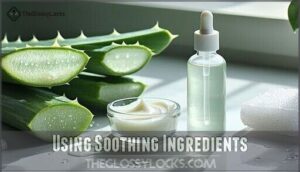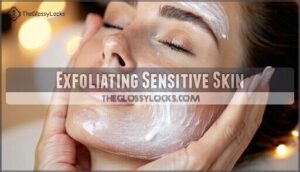This site is supported by our readers. We may earn a commission, at no cost to you, if you purchase through links.

You’ll want to start with a mild, fragrance-free cleanser, followed by a simple moisturizer containing ceramides or hyaluronic acid.
Skip harsh scrubs and alcohol-based products that can worsen irritation.
Instead, focus on strengthening your skin barrier with minimal, proven ingredients like niacinamide and gentle acids.
Daily sunscreen is non-negotiable since sensitive skin burns more easily.
The secret lies in patch-testing new products and introducing changes slowly – your skin will thank you for the patience, and you’ll discover which specific ingredients work best for your unique sensitivities.
Table Of Contents
- Key Takeaways
- Sensitive Skin Basics
- Gentle Cleansing Routine
- Sensitive Skin Care Tips
- Customizing Skin Care
- Maintaining Healthy Skin
- Frequently Asked Questions (FAQs)
- What is the best skin routine for sensitive skin?
- What are the 4 types of sensitive skin?
- What skin treatments are good for sensitive skin?
- Can sensitive skin develop later in life?
- How long before seeing skincare routine results?
- Are natural products always better for sensitivity?
- Can diet changes improve sensitive skin conditions?
- Should I patch test every new product?
- Conclusion
Key Takeaways
- Start with gentle, fragrance-free cleansers – You’ll avoid triggering reactions by choosing mild formulas that won’t strip your skin’s natural protective barrier.
- Build your routine around barrier-supporting ingredients – You should prioritize ceramides, hyaluronic acid, and niacinamide to strengthen your skin while avoiding harsh actives that cause irritation.
- Always patch test new products before full application – You can prevent unexpected reactions by testing products on a small skin area for 24-48 hours before incorporating them into your routine.
- Focus on consistency over complexity – You’ll see better results with a simple, regular routine using proven gentle ingredients than constantly switching between multiple products.
Sensitive Skin Basics
If you’ve got sensitive skin, you’re dealing with a reactive complexion that easily becomes irritated by products, environmental factors, or even stress.
Understanding your skin’s unique triggers and characteristics helps you build a routine that soothes rather than aggravates your delicate barrier.
Definition of Sensitive Skin
Sensitive skin isn’t just about irritation—it’s your body’s heightened response to everyday products and environmental factors. Understanding skin sensitivity defined involves recognizing how your sensory perception triggers reactions beyond normal tolerance levels.
Your skin sensitivity manifests through these key characteristics:
- Immediate reactions to new skincare products
- Persistent redness after mild irritation
- Burning sensations from common ingredients
- Heightened responses to weather changes
- Inflammatory reactions to fragrances or dyes
This skin condition affects millions, creating skin reactions that range from mild discomfort to severe skin allergies requiring specialized care.
Causes of Sensitive Skin
Understanding what triggers your skin’s sensitivity helps you build better protection against irritation.
Multiple factors often work together, creating a perfect storm for reactive skin that demands careful attention.
Your sensitive skin creates a cascade of reactions when multiple triggers converge simultaneously.
It’s worth noting that weakened skin barriers can also be a significant trigger for sensitive skin.
| Category | Common Triggers | How They Affect You |
|---|---|---|
| Genetic Predisposition | Inherited skin barrier weakness, family history of allergies | Makes your skin naturally more reactive to irritants |
| Environmental Factors | Air pollution, UV rays, wind, humidity changes | Break down protective barriers, causing inflammation |
| Product Ingredients | Fragrances, sulfates, alcohol, harsh preservatives | Strip natural oils, triggering allergic reactions |
| Underlying Conditions | Eczema, rosacea, contact dermatitis, hormonal changes | Create ongoing inflammation that worsens skin sensitivity |
Symptoms of Sensitive Skin
Your body will tell you when something’s wrong through unmistakable skin reactions like persistent redness, uncomfortable itchiness relief needs, or burning sensations that make you wince.
Your skin sends clear warning signals through redness, itching, and burning that demand immediate attention.
These dryness signs, along with skin irritation from everyday products, reveal underlying skin sensitivity causes that shouldn’t be ignored, as various skin conditions manifest through skin redness and skin dryness patterns.
Sensitive Skin Types
Four distinct types of sensitive skin require customized approaches based on your unique genetic predisposition and environmental factors.
Each skin type ID reveals specific barrier function weaknesses that influence which sensitive skin products work best.
- Acne-prone sensitive: Combines breakouts with skin irritation from harsh treatments
- Rosacea-prone sensitive: Features persistent redness triggered by heat, stress, or certain ingredients
- Burning/stinging sensitive: Experiences immediate discomfort from most skincare formulations
- Contact dermatitis sensitive: Develops allergic reactions to specific chemicals or preservatives
Understanding your specific skin conditions helps prevent unnecessary skin sensitivity causes; this often stems from a decreased <strong>skin threshold</strong>.
Gentle Cleansing Routine
A gentle cleansing routine forms the foundation of any effective sensitive skin care regimen, helping you remove impurities without triggering irritation or inflammation.
You’ll need to select mild, fragrance-free cleansers and master proper techniques that protect your skin‘s natural barrier while maintaining cleanliness, which is a complete concept in sensitive skin care.
Choosing Gentle Cleansers
When selecting cleansers for sensitive skin, ingredient research becomes your best friend.
Look for gentle skincare options that maintain pH balance, avoiding sulfates and fragrances that trigger reactions.
Cream-based cleanser types work better than foaming formulas for sensitive skin care.
Choosing the right product often involves considering various cleanser formulations.
Always perform patch testing before committing to new hypoallergenic skincare products, and focus on nonirritating skincare with ceramides or niacinamide for ideal results.
Cleansing Techniques for Sensitive Skin
Proper technique transforms cleansing from potential irritation into gentle care.
Water temperature should remain lukewarm, avoiding hot water that strips your skin barrier repair mechanisms.
Cleansing frequency matters—twice daily provides ideal balance without overdoing it.
Pat drying prevents friction damage, while gentle product application using fingertips maintains your sensitive skin cleanser‘s effectiveness throughout your skincare routine.
Many find that using a fragrance-free cleanser helps to reduce irritation.
- Use lukewarm water: Hot water strips natural oils and compromises sensitive skin care
- Cleanse twice daily: Morning and night cleansing maintains balance without irritation
- Apply with fingertips: Gentle circular motions distribute your sensitive skin cleanser effectively
- Pat dry softly: Avoid rubbing with towels to prevent micro-tears in delicate skin
- Focus on gentle skincare: Night cleansing removes daily buildup while preserving skin barrier function
Importance of Moisturizing
Moisturizing immediately after cleansing locks in hydration levels while your skin barrier is most receptive.
Choose a sensitive skin moisturizer with ceramides for barrier repair and ingredient benefits like aloe vera.
Apply twice daily for ideal hydrating skincare results.
Overnight moisture formulas provide deeper skin hydration, supporting skin barrier repair while you sleep, utilizing barrier repair for optimal results.
Avoiding Harsh Ingredients
Everyone deserves skincare that won’t bite back.
Reading labels becomes your superpower for ingredient identification, spotting hidden irritants like sulfates and synthetic fragrances.
Product research reveals fragrancefree products and hypoallergenic skincare options that won’t wage war against your skin.
Choose nonirritating skincare with gentle exfoliation methods, and prioritize a sensitive skin moisturizer with irritant alternatives like ceramides over harsh actives.
Sensitive Skin Care Tips
You’ll want to treat your sensitive skin with care, using ingredients that calm rather than irritate.
The right approach involves selecting gentle products, protecting against sun damage, and avoiding common triggers that can worsen sensitivity, which is crucial for maintaining healthy skin with minimal irritate.
Using Soothing Ingredients
Your skin’s repair-and-protect arsenal starts with powerhouse soothing ingredients.
Aloe benefits include immediate redness relief and deep hydration, while ceramide function restores your barrier like building blocks.
Anti-inflammatory options such as niacinamide and centella asiatica calm irritation effectively.
Hydrating mists deliver instant comfort between steps, and calming masks provide intensive relief.
Choose hypoallergenic skincare with nonirritating formulas for consistent results.
Applying Sunscreen Correctly
Daily sunscreen application creates your first line of defense against UV damage, yet many people skip this essential step.
Broad spectrum sunscreen for sensitive skin requires specific attention to application amount, sunscreen ingredients, and sensitive areas coverage.
- Choose dermatologist recommended, allergy-tested skincare with mineral-based formulas containing zinc oxide or titanium dioxide
- Apply adequate amounts (¼ teaspoon for face) ensuring complete skin sun protection coverage
- Follow sunscreen reapplication every two hours, especially after sweating or washing your face
Sensitive individuals may prefer to use mineral-based sun protection.
Exfoliating Sensitive Skin
After establishing proper sun protection, gentle skin exfoliation becomes your next priority.
Enzyme exfoliation and chemical exfoliants like lactic acid work better than physical scrubs for sensitive skin.
These methods won’t cause micro-tears that harsh scrubbing creates. Start with once-weekly exfoliation frequency to test your skin’s tolerance.
Shaving beforehand can also help reduce irritation. Over-exfoliation leads to irritation, so patience pays off when building your routine.
Avoiding Irritants
Smart shoppers become ingredient detectives when protecting sensitive skin.
Research each product’s formula, focusing on trigger identification through careful patch testing before full application.
Fragrance-free products and hypoallergenic formulas reduce reaction risks substantially.
A minimalist approach prevents product overload, allowing your skin to breathe.
Choose soothing skincare with calming skin products that respect your skin sensitivity triggers.
Customizing Skin Care
Everyone’s skin responds differently to products and environmental factors, so customizing your routine helps you address specific concerns while maintaining gentleness.
You’ll need to identify your particular triggers and sensitivities, then select products that work with your skin rather than against it, which involves maintaining gentleness.
Identifying Skin Concerns
Beyond obvious redness or breakouts, skin sensitivity triggers often hide beneath the surface.
Track skin changes using a simple journal, noting reactions to weather, stress, or new products.
Professional skin diagnosis can reveal underlying skin conditions like rosacea or contact dermatitis that masquerade as general sensitivity, helping you build a targeted skin care routine.
Selecting Suitable Products
Finding the right sensitive skin solutions requires careful ingredient research and product testing.
Start with hypoallergenic labels and dermatologist recommendations, focusing on fragrance-free products and allergy-tested skincare options. Many retailers offer diverse product selections for sensitive skin.
- Read labels thoroughly – Look for short ingredient lists with recognizable, science-backed components
- Prioritize hypoallergenic products – These show lower sensitivity reaction rates in clinical studies
- Consider budget considerations – Sample sizes let you test compatibility without full investment
- Seek professional guidance – Dermatologists can recommend specific skincare ingredients for your concerns
Creating a Personalized Routine
Success starts with understanding your unique skin’s requirements, allowing your skin care regimen to work harmoniously with your lifestyle. Patch Testing remains essential before introducing new skincare products, preventing unexpected Ingredient Sensitivity reactions that could derail progress.
As the beauty industry shifts, many find a customized skincare solution to be a worthwhile investment.
| Morning Routine | Evening Routine |
|---|---|
| Gentle cleanser | Oil-based cleanser |
| Hydrating toner | Treatment serum |
| Lightweight serum | Rich moisturizer |
| Moisturizer with SPF | Overnight treatment |
| Sunscreen application | Calming face mask |
Product Layering follows a simple rule: thinnest to thickest consistency. Your sensitive skin solutions should complement each other, creating synergy rather than competition.
Routine Adaptation occurs gradually—introduce one new product weekly to monitor reactions. Lifestyle Factors like stress, diet, and sleep directly impact skin sensitivity, requiring skincare advice that considers your complete daily pattern rather than isolated product performance.
Adjusting to Seasonal Changes
Your routine needs tweaks when seasons shift, as skin sensitivity fluctuates throughout the year.
Winter dryness demands richer moisturizers, while summer sensitivity requires lighter, breathable formulations.
Spring allergies may trigger inflammation, necessitating fragrance-free products and gentle care.
Fall exfoliation helps remove summer damage before harsh weather arrives.
- Winter warriors: Layer hydrating serums under thick creams to combat seasonal SPF needs and harsh indoor heating
- Summer survivors: Switch to gel-based moisturizers and mineral sunscreens that won’t clog pores during humid months
- Spring soothers: Introduce anti-inflammatory ingredients like chamomile to calm reactive skin during allergy season
- Fall fixes: Gradually incorporate gentle exfoliants to repair summer damage while preparing for winter’s skin protection challenges
Maintaining Healthy Skin
Maintaining healthy sensitive skin requires consistent hydration and environmental protection to prevent irritation flare-ups.
You’ll need to monitor your skin’s response to products and adjust your routine based on seasonal changes, stress levels, and how your skin reacts over time, which involves consistent efforts and understanding of environmental factors.
Hydrating Sensitive Skin
After establishing your personalized skin care routine, maintaining proper hydration becomes your skin’s lifeline.
Sensitive skin loses moisture faster than other skin types, making consistent hydration your best defense against irritation and inflammation flare-ups.
| Hydration Strategy | Application Tips |
|---|---|
| Humectant Benefits | Apply hyaluronic acid serums to damp skin for maximum water retention |
| Occlusive Options | Use petroleum jelly or dimethicone-based products as final evening step |
| Emollient Choices | Select ceramide-rich moisturizers to repair and strengthen skin barrier |
| Hydration Frequency | Moisturize twice daily, with additional applications during dry weather |
| Layering Products | Apply thinnest to thickest consistency for ideal skin moisturization |
Your skin sensitivity responds best to consistent care rather than sporadic intense treatments.
Think of hydration like watering a garden – little and often beats flooding then drought.
The skin hydration impact becomes visible within days when you layer products correctly, allowing each formula to absorb before applying the next.
Your skin care products work synergistically when properly sequenced, creating a protective moisture barrier that shields against environmental stressors while supporting your skin’s natural repair processes throughout your skin care routine.
Protecting Skin From Environment
Environmental protection forms your skin’s first line of defense against daily aggressors.
UV exposure amplifies pollution effects, creating oxidative stress that weakens barrier repair mechanisms.
Weather sensitivity increases when antioxidant protection is inadequate.
Daily broad-spectrum SPF 30+, HEPA air purifiers, and ceramide-rich moisturizers create effective skin protection strategies.
These skin sensitivity prevention methods support thorough skin sensitivity care through proven skin care best practices.
Managing Skin Stress
Daily stress substantially impacts skin sensitivity management through compromised barrier function and heightened inflammation response.
When you’re overwhelmed, cortisol levels spike, triggering inflammatory pathways that worsen product sensitivity.
Your skin’s natural defenses weaken, making it more reactive to environmental irritants, and lifestyle factors like poor sleep and rushed routines amplify these effects.
Creating a vicious cycle where stress breeds more skin stress, leaving your complexion feeling raw and unpredictable due to heightened inflammation response and compromised natural defenses, ultimately affecting skin sensitivity and overall complexion.
Monitoring Skin Progress
Track your skin’s response through a Visual Skin Diary, noting Tracking Irritation Levels and Hydration Level Changes weekly.
Document Product Effectiveness Timeline over 4-6 weeks, photographing progress for accurate skin sensitivity management.
Professional Skin Analysis every few months provides expert insight into your skin care routine’s success, helping identify which skin sensitivity products deliver superior results and aiding in skin sensitivity management.
Frequently Asked Questions (FAQs)
What is the best skin routine for sensitive skin?
Ironically, sensitive skin demands the gentlest approach. You’ll need fragrance-free cleansers, lukewarm water, ceramide-rich moisturizers, mineral sunscreen, and limited exfoliation to prevent irritation while maintaining healthy skin.
What are the 4 types of sensitive skin?
You’ve got four main types of sensitive skin to watch for: naturally sensitive (born that way).
Environmentally sensitized (damaged by external factors).
Reactive (allergic responses).
And thin skin (easily irritated due to reduced barrier function).
What skin treatments are good for sensitive skin?
Research shows 64% of people worry about exposing sensitive information.
Yet your skin deserves gentle care.
You’ll benefit from enzyme exfoliators, mineral sunscreens, ceramide moisturizers, and anti-inflammatory serums that soothe without irritation.
Can sensitive skin develop later in life?
Yes, you can develop sensitive skin later in life due to hormonal changes, aging, medical conditions, medications, or increased exposure to irritants and environmental stressors over time.
How long before seeing skincare routine results?
Like watching a garden bloom, skincare results unfold gradually—you’ll typically notice initial improvements in skin texture and hydration within 4-6 weeks,
while more significant changes require 8-12 weeks of consistent use.
Are natural products always better for sensitivity?
Natural doesn’t automatically mean better for sensitive skin.
Some natural ingredients like essential oils, citrus extracts, or fragrances can trigger reactions.
You’ll find gentler synthetic ingredients that work better than harsh natural ones.
Can diet changes improve sensitive skin conditions?
Diet modifications can substantially impact sensitive skin by reducing inflammation and supporting barrier function.
You’ll want to increase omega-3 fatty acids, antioxidants, and probiotics while limiting sugar, dairy, and processed foods that trigger flare-ups.
Should I patch test every new product?
Like medieval alchemists testing potions before consumption, you should absolutely patch test every new skincare product.
Apply a small amount behind your ear or on your inner wrist, wait 24-48 hours, and watch for reactions before full application.
Conclusion
Mastering your sensitive skin care routine transforms what feels like an impossible skincare puzzle into manageable daily habits.
Your persistence with gentle cleansers, barrier-supporting moisturizers, and diligent patch-testing creates the foundation for healthier, more resilient skin.
Remember that consistency trumps complexity when managing sensitivity, so stick with proven ingredients like ceramides and niacinamide while avoiding common irritants.
Most importantly, listen to your skin’s signals and adjust accordingly—building an effective sensitive skin care routine isn’t about perfection, it’s about finding what works uniquely for you, which requires persistence.
- https://docs.google.com/forms/d/1GAQr3Kn1cURCVHUA82hAga1Wv8DCH0IuqDLRUrOpN7M/viewform?ts=63f4f653&entry.1515682415=https://www.merriam-webster.com/dictionary%2Fsensitive
- https://premium.britannica.com/mw-unabridged/?utm_source=mw&utm_medium=inline-def&utm_campaign=evergreen
- https://blog.collinsdictionary.com/cefr-labels-explained/
- https://www.dermalogica.com/blogs/living-skin/could-your-sensitive-skin-be-caused-by-your-environment
- https://pmc.ncbi.nlm.nih.gov/articles/PMC10726041/













